 | ||
|
Page 3. Tools and materials (continued)
Brush and ink As I mentioned above, truly flexible fountain pens are becoming increasingly difficult to find since they are no longer produced. For this reason, I recommend you learn how to use a brush or brush pen since these are readily available and are more flexible than any fountain pen. Brushes give the most expressive lines from very wide to literally a single hair line all in one stroke. If held perpendicular to the paper, they can produce a thick or thin stroke in any direction, which is something a flexible nib pen cannot do well. Brushed lines are not as wet as those made by fountain pens, which means they dry quicker. You don't have to wait as long to paint watercolor over brushed ink lines. Once you can draw naturally with a brush, you will no longer have to search for those vintage flexible fountain pens which are so hard to find, and have become so expensive. Drawing inks There are so many different drawing inks out there, I can't begin to describe them all. If you want to make ink and watercolor sketches, then you'll need waterproof ink such as india ink If you are drawing in ink alone and don't require waterproof ink, then you have a wide variety of inks to choose from. The two non-waterproof inks I am most familiar with are the ones I can get at most stationery shops in Tokyo. They are from Pilot and are called SHOKENYO (document ink) and SEIZUYO I won't take up space here to describe how these two inks are different, but for those who are interested, I have written a separate article on the subject called Pilot bottled inks for dip pens.
Ink stick and grinding stone
This ancient method of producing ink is still practiced by artists and calligraphers, and the ability to produce ink of the right consistency is a skill that students of the brush must acquire. Some ink sticks are ornate with painted decorations, like the one in the photo, to the left of the grinding stone. Grinding stones can also be plain or ornate. Ink sticks, grinding stones and brushes vary in quality and price from very cheap to extremely expensive collector's items.
Sumi ink is also available in liquid form which makes grinding no longer necessary (although a lot of people still prefer grinding their own for various reasons, including the richness of the experience itself, which can be sort of a ritual). It's called bokuju in Japanese, and bottles of liquid sumi can be found easily on the internet or possibly at your local art store. Here are the two brands I see most often in Japan, one is Kaimei and the other is Kuretake.
It is made by Kaimei and is apparently only available in certain stores in Japan where it has gained popularity among ink and watercolor artists. This is what I use when I'm sketching with with my yatate and watercolor (I water it down a little for drawing detail). One bottle lasts a long time. If you do a web search for it in kanji, you may find a vendor. I believe Amazon in Japan has it. A web search for the English MOKKAN BOKU will probably bring up not much more than my web site at the present. As you can imagine, with such a strong waterproof ink as this, it is absolutely crucial that you thoroughly wash your brush soon after you are finished using it. Yatate In Japan the yatate eventually replaced the ink stick and grinding stone for outdoor use since the Kamakura period (from the 10th century). They are usually made of metal and contain a Japanese bamboo brush and an ink pot filled with cotton or silk which holds liquid sumi ink. The yatate is still used by calligraphers and artists in Japan and around the world, and they are definitely classy if you can find one. Although the yatate was the only portable ink writing and drawing tool for centuries, most Japanese don't even know what a yatate is now. In old Japan they used to tuck these in their waist sash (obi) but you can easily tuck one in your belt if you are wearing one. 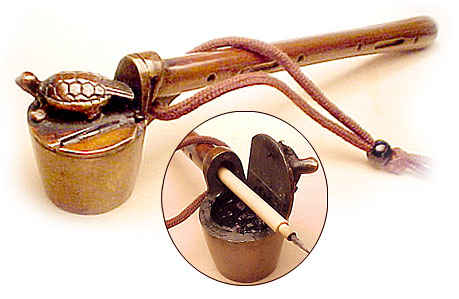 Ornate yatate with a turtle figure on the ink pot lid. Most yatate that you will find now are practically antiques, although new ones are still being produced in very limited quantities. It's best to wash the brush every time you use it to keep it supple and responsive, but I know many yatate users prefer to keep a little ink in their brushes, and most antique yatate I have found contained old brushes full of dry hardened ink. The yatate is very classy and a real conversation piece. It's one of the few art tools you can polish up and display on your mantlepiece. I have also heard a heavy brass yatate also makes a good self defense weapon in a pinch. For more information on the yatate, see my article, What is a yatate?. My own well used yatate with bamboo brush. This yatate is 17.5 cm long, which is average or slightly small for a yatate. As for my favorite drawing brush, I prefer a type of brush called MEN-SOU FUDE (see the photo below for the kanji) which has a thin natural hair tip and is used to draw features such as eyebrows on dolls. My favorite MEN-SOU FUDE is handmade by a brush maker in the Nezu area of Tokyo. These brushes come in two sizes, medium and small. I use the small size, and it costs around 1,300 yen as of this writing. Of course, this information is totally useless to anyone who does not shop for art supplies in Tokyo! As for what is available to most people, I have found the Winsor & Newton Series 7 Sable Brush I have a few of these brushes and they are just as good, if not better than my bamboo brushes. They cost about the same, but don't look as traditional in a yatate if that is important to you. Anyway, since the yatate is not available to most readers, I won't take up more space here praising them since it will only stir up desires that can't easily be satisfied. But I must say that this is my preferred drawing tool on location. Nothing beats a real bamboo brush charged with real sumi ink, and they make me a better artist. The yatate allows me to indulge in these luxuries while sketching outside. I would probably not use it in a subway (although I have in the past) because a brush pen is more practical in such situations, and is almost as good. And I must confess that I sometimes prefer a brush pen because I'm lazy and don't enjoy cleaning my brush every time. Today a lot of brush writing and drawing in Japan is done with brush pens which are basically fountain pens with brush tips instead of metal nibs. Some have synthetic bristles, and some are made of animal hair such as weasel and sable. Brush pens take ink cartridges or even ink converters and are very convenient. Who would have thought we could go around carrying a brush and ink in our pockets? Kuretake brush pen, numbers 13 and 15 Some of the more high end brush pens come from Japanese brush pen companies such as Kuretake, Kaimei and Takara. Of these three, Kuretake Brush Pens The pen in the photo is the number 15 brush pen, which has an urushi lacquer finish and rounded ends. This model may be hard to find outside of Japan, but Kuretake makes an almost identical brush pen, the number 13, which is more widely available and performs exactly the same as the number 15. Kuretake Sumi Ink
For what it's worth, I have discovered that Kuretake ink eventually becomes nearly waterproof, and I have no idea why. If you paint over the ink lines with water after a few weeks it will produce very light gray wash, which is very different from the black mess it will make within the first few days. Kuretake brush pens with Platinum Carbon Ink
Kuretake Sumi Ink vs. Platinum Carbon Ink While Kuretake Sumi Ink cartridges and Platinum Carbon Ink cartridges are the exact same size and shape, the ink inside is very different, and each has its good points. Kuretake Sumi Ink is not waterproof while Platinum Carbon Ink is completely waterproof when it dries. So if you are using both ink and watercolor, your best option is Platinum Carbon Ink. But if you draw in ink alone, I can think of two reasons why you would want to use Kuretake Sumi Ink instead of waterproof Platinum Carbon Ink, and they are also the same factors I mentioned above in the differences between the two Pilot inks. First, Kuretake Sumi ink has a flat matt finish when dry while Platinum Carbon Ink has a more glossy finish. This could be an important factor if you want to photograph the art since a matt finish makes it easier to get a clear photo without light bouncing back at you from the black areas. Secondly, although Carbon Ink dries quickly on the paper and becomes waterproof, some of the dry surface ink can transfer to the facing page in a sketchbook and leave a ghost mirror image, depending on the paper and the concentration of ink. This could be a serious problem if you are drawing on facing pages in a double page spread. Kuretake ink leaves little or no ghost image on the facing page, depending on the paper. Again, this ghost image problem only happens with ink drawings that don't have watercolor. I have found that a layer of watercolor paint on top of the Carbon Ink drawing prevents the ink from transferring to the facing page. Kuretake Sumi can stay wet even after several minutes, forcing you to stop drawing or risk accidentally dragging wet ink around the paper. This varies with the paper; smooth surfaces tend to keep the ink wet longer while absorbent textured surfaces let the ink dry much quicker. Carbon Ink dries quickly on the paper. Also, I have found that if you are drawing for a long time, leaving the brush tip exposed to air, a brush pen with Kuretake Sumi Ink will go dry, causing the ink line to break up and even stop while the Platinum Carbon Ink will continue to give you a wet solid line. If the Kuretake brush pen goes dry, you will have to either cap it and stop using it until it becomes useable again, or wet it with a little water. But don't give it a "thermometer shake" in order to get the ink flowing again; aside from the obvious danger of an "environmental disaster" if you don't cover the end with a tissue paper, this will cause ink to flood the tip section. Then there will be a constant seeping of ink through the side vent holes resulting in inky fingers for a long time until it settles down. Another advantage of Platinum Carbon Ink is that it comes in a bottle so you can use a converter. I don't know if the Kuretake Sumi Ink in cartridges is the same as any of Kuretake bottle inks out there, and I don't want to destroy any more brush tips trying to find out. Ink Converters If you have a Platinum piston type ink converter,
If you use an ink converter with a brush pen, I would recommend that you remove the converter from the brush pen and fill it apart from the brush pen rather than dip the brush part in the ink bottle, which will flood the brush and ink chamber with ink, and get ink all over your fingers for a while. A regular fountain pen does not have this problem, so you can keep the converter in the pen and dip the nib into the ink bottle. An airtight cap Here's a tip for those who use carbon ink in their Kuretake brush pen: the cap that comes with this pen is not airtight and the brush can dry out if you don't use it regularly. However, if you have a replacement tip (which is always a good thing to have on hand) it comes with a disposable clear soft plastic cap which is very airtight. I used that disposable cap instead of the regular cap for many years, and the tip stayed soft and ready to use even if I hadn't used it for a few months. As you can see in the photo above, it's not as pretty as the regular cap, but that's the price to pay for keeping the tip fresh. Kuretake number 8 brush pen Kuretake makes another brush pen with synthetic bristles which takes cartridges (including Platinum Carbon ink cartridges) and makes a wonderful line like the model above. It's their Number 8 Pen The only drawback is its length. A bit too much for the pocket when sketching on location, but not impossible. I've carried it in my pocket before but mainly keep it in my bag to use at my desk and not on location. The extra length really makes this a nicely balanced pen, and like any desk type fountain pen, it feels great to hold and use. Kuretake Yume-Ginga Brush pen Kuretake makes a wonderful natural weasel hair brush pen called Yume-Ginga (Dream Galaxy) These brush pens also look very classy and come in a variety of colors and designs. My red one in the photo is apparently no longer available, but the product line has greatly expanded to include incredibly beautiful models with a maki-e finish. I think their target audience is older well-to-do Japanese who are able to invest in a top-of-the-line brush pen that will impress their colleagues. I've been using my Yume-Ginga brush pen for many years for black and white drawings, when waterproof ink is not needed. I don't use Platinum Carbon Ink in a Kuretake Yume Ginga brush pen because the natural hair bristles will clog up and become useless (I found out the hard way). However, this brush pen is a real joy to use with the Kuretake ink cartridges intended for these pens. Platinum weasel hair brush pen As mentioned above, I have always avoided using Platinum Carbon Ink in a Yume Ginga natural hair brush pen because it will ruin the bristles. Neither the brush pen version nor the fountain pen version of Carbon Ink worked with this natural weasel hair brush. As a matter of fact I stubbornly ruined several brush tip units, refusing to accept the results until I finally slapped my forehead and came to the conclusion that Platinum Carbon Ink simply does not go with natural weasel hair brush pens. But Platinum has proven me wrong with their own version of the weasel hair brush pen. They didn't give it a fancy name, but simply called it the CF-5000 Natural Weasel Hair Brush Pen The brush tip is slightly longer than my Kuretake brush pens, and the taper is more subtle so it is easier to produce consistently thin hatch lines again and again with no surprises.
And the natural hair bristles are more responsive than synthetic hair bristles. The cap on this brush pen is a click-on type (not a screw-on type) and is apparently air-tight. I haven't noticed any drying of the brush when it was capped between drawing sessions. However, there is one caveat. This brush pen came with an ink cartridge that contained Platinum Carbon ink for brush pens. As I've mentioned above, Platinum makes two types of Carbon ink; one for brush pens, and one for fountain pens. The ink for brush pens has a gold imprint in Japanese that identifies it as brush pen carbon ink. The ink for fountain pens has a silver imprint that just says "CARBON INK" in English. The Carbon Ink for brush pens is extremely black and has a matt finish, but I found it to be a little smudgy and chalky until it totally dried a few hours later, and even after it has totally dried -- even a few months later -- it will still rub off onto the facing page and leave a faint ghost mirror image. But after the ink dries, it's completely waterproof. Still, I can't think of a good reason to use this instead of the fountain pen carbon ink in my brush pen. I suppose that since Japanese culture has a long history of brush calligraphy, some people insist on that dark matt black finish which looks so great on letters and certificates. So I got to thinking that since Platinum had already achieved the impossible by making a natural hair brush pen compatible with Carbon ink for brush pens, maybe it would also work with my good old Carbon Ink for fountain pens, which dries almost immediately and becomes waterproof. I gave in to temptation and flushed the brush pen out and inserted a regular Carbon Ink for fountain pens cartridge, knowing that I would probably ruin yet another brush tip unit. As it turns out, this brush worked very well with Carbon Ink for fountain pens, and I was relieved and overjoyed. This is truly an amazing brush pen! For me, this is the ultimate brush pen for drawing. And it looks great in the pocket and in the hand! Sailor Profit brush pen Sailor also makes a good brush pen with synthetic bristles, the Profit Brush Pen This ink flows freely (because the brush pen was designed for this particular ink) and is completely waterproof when dry.
This brush pen is nicely balanced with the cap posted, which is not the case with Kuretake brush pens which become top heavy when capped. It also looks great in your pocket, like a regular fountain pen with the exception of the gold kanji for brush (FUDE) on the cap. The brush tip is more abruptly tapered, going from very fat to very thin in a very short distance, so if you change the pressure in the middle of a line you may find it suddenly go much wider or thinner than expected. Because of this, I found it very difficult to get consistent fine lines with this brush pen. But it's great if you prefer drawing boldly with wider brush lines. Disposable Kuretake brush pens Many pen companies also make disposable brush pens, which are very popular in Japan, especially for writing messages on new year post cards. The selection of disposable brush pens seems to increase every year. Pentel brush pens have been popular in the west for many years. Most disposable brush pens do not have waterproof ink, but there are a few waterproof disposable brush pens out there. Zebra makes a disposable brush pen with waterproof ink. It has a brown plastic barrel, and comes in a few tip sizes. If you sketch in a small sketchbook (no larger than F3 -- or just under 9" X 12") you won't see any difference between the sizes since you will probably only use the very tip of the brush anyway. If your sketches are large, then a broad size would make it easier to get wide strokes that are nice and wet. If you compare the sample strokes below from a Kuretake medium, extra fine, and broad tip brush pen, you will see the tips are visibly different in size, while the difference in stroke width is more subtle. Kuretake disposable waterproof brush pens, numbers 24 (extra fine) 22 (medium) and 26 (broad) These three brush pens are from Kuretake, and they are filled with waterproof ink. They are the model numbers 24 (extra fine tip, yellow cap), 22 (medium tip, black cap), and 26 (broad tip, red cap). In the close up photo below, you can see that the larger the size, the smaller the plastic shield is surrounding the tip, allowing for more bristle to be exposed, and giving you a potentially wider swash when you need it. Did you notice the numbers don't match the order of size? This is apparently because they were not produced in order according to size.
The ink in these Kuretake ink brush pens usually becomes waterproof almost immediately after it touches the paper. In cold weather it takes more time before the ink sets and becomes waterproof. I discovered this one winter when I started to add watercolor to my ink sketch and ended up with a muddy gray mess. Even on a hot, humid summer day the ink may smudge a bit from the larger tips because there is so much more ink on the paper. Again, I suggest making a few test strokes in the margin or another piece of paper to determine whether or not they will run before applying watercolor to the main sketch. Most disposable brush pens have the same basic design as these Kuretake brush pens, long and fat with a squeeze barrel and no clip. Some people may find them slightly awkward to use, because they prefer a thinner barrel for better line control. Others won't find the girth a problem, and may actually prefer it, especially for large sketches. Of course, you will have to carry these in a bag since they are too long for a shirt pocket, and would fall out the first time you bend over (pray that it is not over a toilet). Copic Gasenfude brush pen The best disposable brush pen with waterproof ink I have found is the Copic "GASENFUDE" brush pen. This is a curious kanji combination I can't find in any dictionary. GA means picture and SEN means letter or composition, and FUDE is brush, so I guess it's a brush for producing both pictures and letters. This is not a fiber tip like the Copic Multiliner brush pen, but an actual nylon bristle brush. The ink is the same as what they use in Multiliner pens, very black, and waterproof when dry. Unlike most disposable brush pens, the Copic is the size of a regular pen, has a clip on the cap, and therefore fits very nicely in a shirt pocket. This is a wonderful brush pen with nice balance, nice wet flow, and great waterproof ink. It can be found in Japan at some art supply stores stores and from online vendors.I asked the maker if these were available outside of Japan, and they replied that the shipping conditions are apparently a bit too rough on these pens, which would make them concerned about potential leak problems en route (maybe it also has something to do with the decreased air pressure in the cargo area on planes, which can cause most fountain pens to leak as well). Instant tones in ink One neat thing you can do with brush pens if you have more than one is fill one with ink wash (ink diluted with water) for quick shading of mid tones. You can also use a full strength gray ink that achieve the same effect without messing with ink and water ratios. I used Platinum carbon ink for the blacks and Private Reserve Gray Flannel ink for the gray tones in the sketch on the right. In Japan you can buy disposable brush pens filled with gray ink. These were originally intended for writing on money envelopes given at at funerals where ink is traditionally thinned to make gray characters instead of black. Thinned sumi ink is called USU-ZUMI. I have bought and tested many USU-ZUMI brush pens, and have found the best one to be the Pentel Usuzumi brush pen FL3L Another great way to get grays in your ink sketch is to use the ink cartridge that came with the brush pen, since it is most likely water soluble ink (at least until it sets in a few weeks) and simply brush plain water in the areas you want to color gray. Just touching an ink line with a wet brush will cause the ink to spread in gray tones, and with a little practice, you can control these and make them go where you want. Still these gray explosions can be unpredictable, and can add to the liveliness of your sketch. This sketch done with water soluble ink in a brush pen. The grays were coaxed out of the black lines with a waterbrush. Size: 13 X 18 centimeters Time: 30 minutes. How to hold them Brushes and brush pens are more difficult than pens to master, and with the exception of some comic book artists, few people in the west draw with brushes anymore. With a brush there is no tactile feedback. You can't just bear down and feel the brush communicate with the paper like a pen or pencil. The brush has to hover over the paper, and you need to support your hand on one or more fingers. Supporting your hand on the middle finger gives you the most consistent line and firm control while supporting it on your little finger gives the most line expression and the least control. 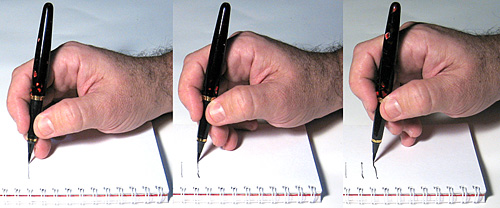 Holding a brush pen while resting the hand on the middle finger, ring finger, and little finger. Notice how the spot where the fingers hold the pen is further from the paper with each position. Sumi-e artists let the entire hand hover over the paper with no support at all. I support my hand on both the ring finger and little finger, curving them in, and resting the hand lightly on the finger nails or first joint or somewhere near there. When I need tight control such as a straight line, then I switch the weight to the middle finger. You will find that you can draw lines and arcs at certain angles better than others. Usually for right handers, a horizontal arc from left to right is the easiest to draw while a vertical line is the most difficult. Simply rotate your sketchbook to get the best angles. It may take a few years before you can draw with the brush as naturally and accurately as you can with a pen, but the time spent practicing is well spent. Try drawing exclusively with a brush for a few months and see how much you improve in a short time. And drawing with a brush is very rewarding!
More on brush drawing and the beauty of line on page 13. Brush pen maintenance: How to fix hooked tips The very tip of a brush pen usually consists of a few hairs, tapering down to just one hair. This tip for some reason can bend into a hook shape very easily. I used to replace them when this happened because it affects fine lines. However, I discovered they can be fixed easily (I don't want to think about how much money I threw away before I made this discovery!). |
Next page >> |
 |
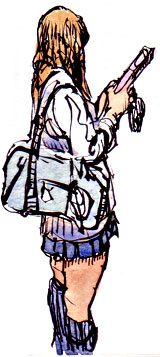
 Liquid sumi
Liquid sumi
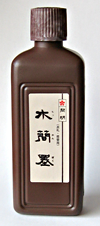 There is even a waterproof liquid sumi called MOKKAN BOKU which is used for painting on wooden signs outside where they will be exposed to the elements.
There is even a waterproof liquid sumi called MOKKAN BOKU which is used for painting on wooden signs outside where they will be exposed to the elements. 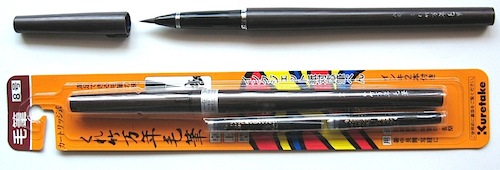

 The barrel is slightly more slim than my Kuretake brush pens which means I can get better line control.
The barrel is slightly more slim than my Kuretake brush pens which means I can get better line control.
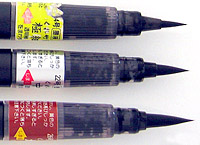
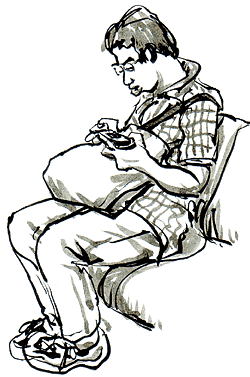 They plan on producing a new version that can withstand the problems associated with overseas transport.
They plan on producing a new version that can withstand the problems associated with overseas transport.